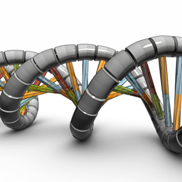
double helix
The double helix is a description of the molecular shape of a double-stranded DNA molecule. In 1953, Francis Crick and James Watson first described the molecular structure of DNA, which they called a "double helix," in the journal Nature. For this breakthrough discovery, Watson, Crick, and their colleague Maurice Wilkins won a Nobel Prize in Physiology, or Medicine, in 1962. However, a crucial contribution that enabled this discovery was made by Rosalind Franklin, who was not acknowledged at that time. After her death, Crick said that her contribution had been critical.
The double helix describes the appearance of double-stranded DNA, which is composed of two linear strands that run opposite to each other, or anti-parallel, and twist together. Each DNA strand within the double helix is a long, linear molecule made of smaller units called nucleotides that form a chain. The chemical backbones of the double helix are made up of sugar and phosphate molecules that are connected by chemical bonds, known as sugar-phosphate backbones. The two helical strands are connected through interactions between pairs of nucleotides, also called base pairs. Two types of base pairing occur: nucleotide A pairs with T, and nucleotide C pairs with G.
Further Exploration
Concept Links for further exploration

















